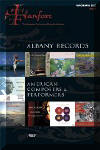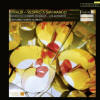Texte paru dans: / Appeared in:

Fanfare Magazine 35:4(03-04/2012)
Pour
s'abonner / Subscription information
Les abonnés à Fanfare Magazine ont accès aux archives du
magazine sur internet.
Subscribers to Fanfare Magazine have access to the archives of the magazine
on the net.
Ambronay
AMY029

Code-barres / Barcode:
3760135100293
Consultez toutes les évaluations
recensées pour ce cd ~~~~ Reach all the evaluations located for this CD
What if Antonio Vivaldi had actually written a cohesive set of Psalm settings for St. Mark’s Cathedral a century after Claudio Monteverdi’s publication in 1610 of his complete setting? Given that Vivaldi was hardly in a position in Venice to write something of this magnitude, such a suggestion is of course moot, but conductor Leonardo García-Alarcón simply uses it as a pretext to highlight his collection of Psalm settings written as separate pieces over the course of two decades by placing them within a fantasy context. The musicologist in me is convinced that Vivaldi would have approached a large-scale sequence such as this in a more integrated manner, but cobbling these movements together in no way diminishes either the idea or the music itself. Thus, this is a collection with considerable merit, at least in terms of programming.
There is something quite comfortable about Vivaldi as a composer of vocal music. The style is unmistakable, with skirling strings, often violins in unison playing tortuous runs, and vocal lines that are inevitably either block homophony with some interesting harmony or extremely virtuosic, requiring singers to have the grace and flexibility of instruments such as the violin. The result is on a large scale predictable but with a rich variety and subtlety that offer something new at every twist and turn. In short, he knew very well what he was about, and if the sacred music is not exactly sedate or rigorously contrapuntal enough for the church, it is certainly glorious music that can survive wherever it is to be performed.
The majority of these works should be of no surprise to anyone, having been recorded before, sometimes frequently. The Laudate pueri, for instance, is a marvelous vehicle for the display of soprano vocal fireworks, being fiendishly difficult and requiring a facile voice in order to tackle the often gnarly fioritura in the lines. The Magnificat is also well known, being a much preferred alternative to the overplayed (and over-recorded) Gloria, RV 589. What is a surprise is the integration that García-Alcarón provides for the group as a whole. Each of the Psalms of the Vespers is led by a brief section of Gregorian chant, setting the mood. Both the voices and the early-instrument ensemble Les Agréments are well suited to each other, neither dominating Vivaldi’s often contrary part-writing. For instance, in the Dixit Dominus, the rapid scalar passages in the violins merge into the homophonic choral parts, being appropriately active in the instrumental introduction but receding easily into the necessary complementary supporting role. The solo voices, several of which are also part of the disciplined Namur Chamber Choir, are also flexible and blend well together. The duet of Maria Soledad de la Rosa and Mariana Flores is quite angelic in the opening movement of the Beatus vir and in the Lauda Jerusalem, while in the Esurientes of the Magnificat, Flores and chorus member Caroline Weynants are lighter in tone but equally spot-on in terms of phrasing and pitch. I like both Fernando Guimarães’s and Alejandro Meerapfel’s sonorous tenor and bass voices in the Confitebor and Beatus vir. It is a pity that Vivaldi did not make more use of male vocal solos, but it is known that he preferred the sound of the female voice. Using Fabián Schofrin’s countertenor in these works, as well as in the Magnificat, provides a nice depth, although it is likely that the parts he sings were also meant originally for women.
What García-Alcarón has done with this set is to bring Vivaldi to life in an extremely delightful way. There are other recordings of all of this music out there that are in their own way equally accurate and musical, but for my money, this sets my standards for Vivaldi’s sacred music. Highly recommended.
Cliquez l'un ou l'autre
bouton pour découvrir bien d'autres critiques de CD
Click either button for many other reviews


